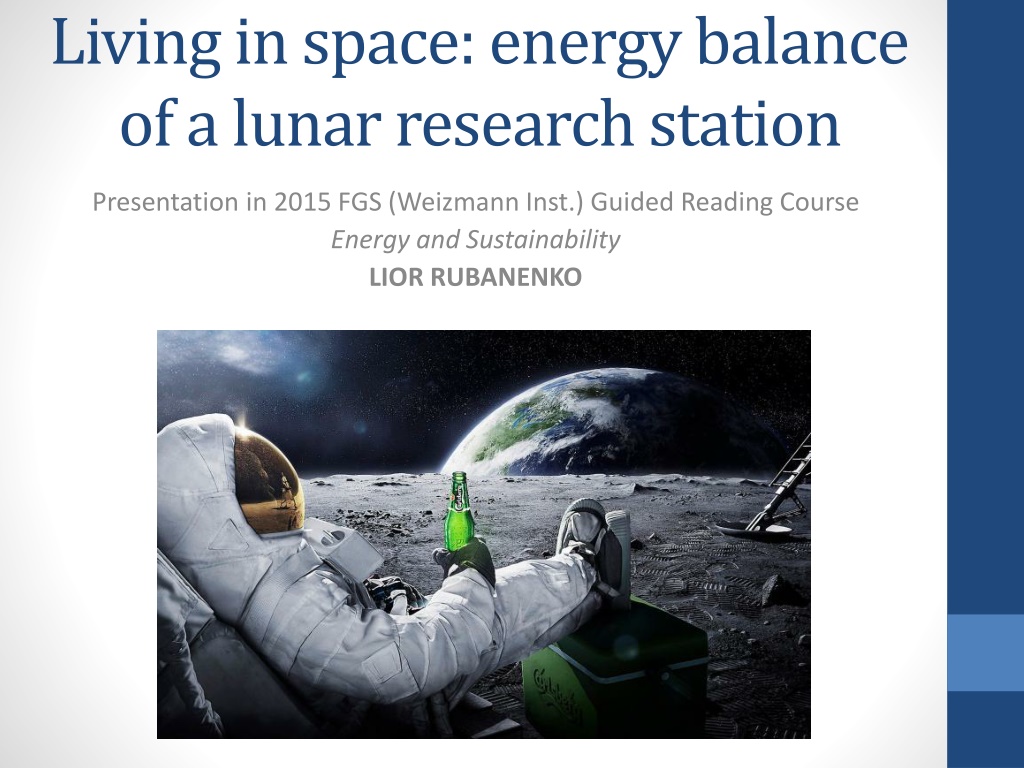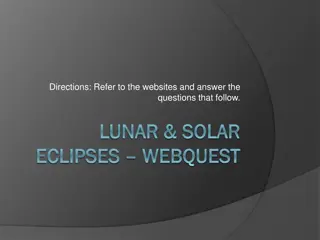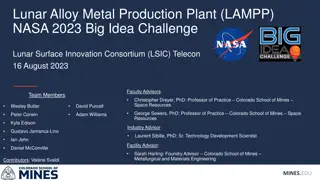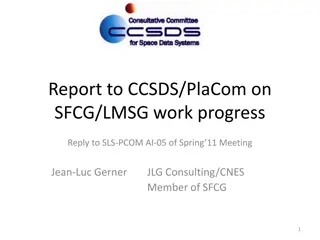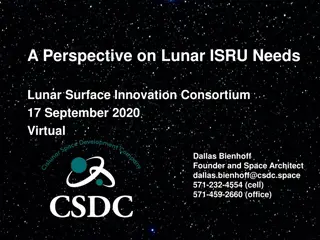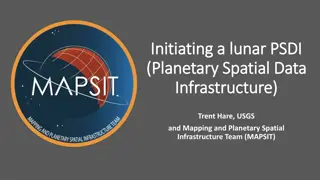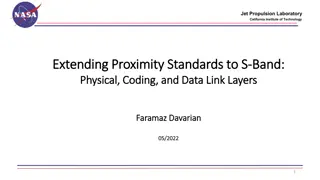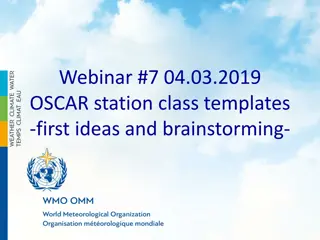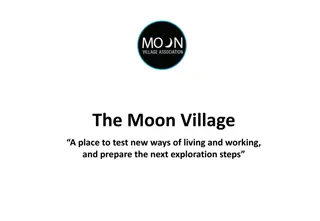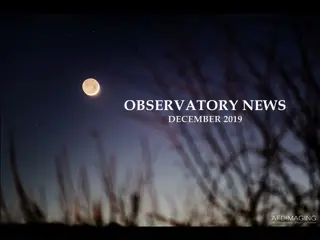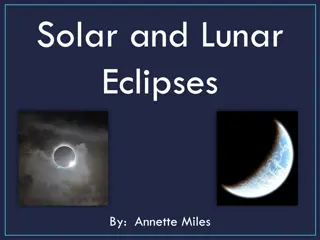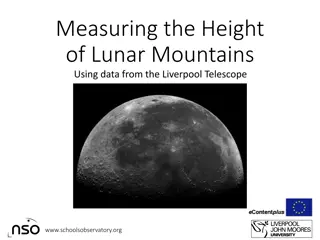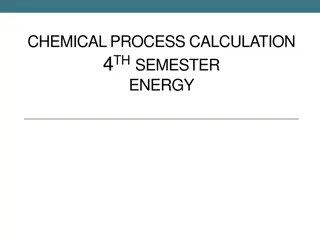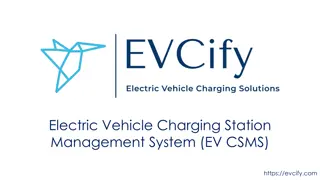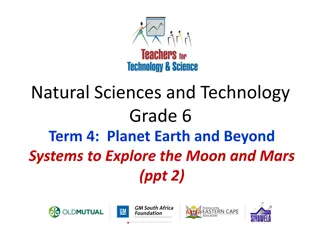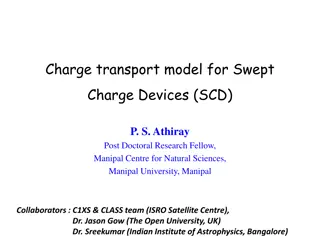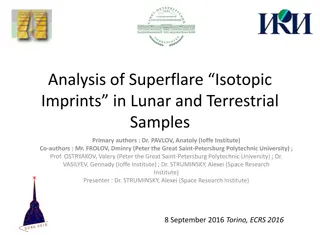Energy Balance of Lunar Research Station: Challenges and Solutions
Delve into the energy balance of a lunar research station, exploring motivations for space living, past experiments like BIOS-3, and the project outline. The presentation discusses the use of algae or high vegetation for oxygen production, emphasizing the need for a sustainable environment in space. Challenges such as the lunar environment's vacuum and energy production during the night are highlighted alongside potential solutions.
Download Presentation

Please find below an Image/Link to download the presentation.
The content on the website is provided AS IS for your information and personal use only. It may not be sold, licensed, or shared on other websites without obtaining consent from the author. Download presentation by click this link. If you encounter any issues during the download, it is possible that the publisher has removed the file from their server.
E N D
Presentation Transcript
Living in space: energy balance of a lunar research station Presentation in 2015 FGS (Weizmann Inst.) Guided Reading Course Energy and Sustainability LIOR RUBANENKO
Motivation #1 (why?) Earth physics are different from Space physics . 2?? ? ~11.2?? Earth s escape velocity is ??= ?. Launching rockets from Earth is a waste of energy. Dangerous. Extremely expensive. Earth won t last forever. Resources. Creating a new habitat.
Motivation #2 (where?) 1. Space station / space city: Very expensive and technologically advanced ( futuristic ). World wide effort (which we are quite far from). Living without natural gravity is difficult. 2. A different planet: Mercury and Venus: too warm. Mars is a good (yet far away) candidate. Exoplanets are beyond our reach. 3. Earth s satellite: Relatively close. Physically similar to space (vacuum environment, low gravity). Earthlike temperatures in temperate latitudes.
Past experiment: BIOS 3 (Salisbury, et al., 1997) Preceded by BIOS-1 and 2. Set up in 1972. Located in Siberia. Goal: test the possibility of living in an outer-space colony.
Past experiment: BIOS 3 (Salisbury, et al., 1997)
BIOS 3: algae or high vegetation? (Salisbury, et al., 1997) Algae High vegetation Produce Oxygen and remove . Produce Oxygen and remove . Reliable Transpire water (that can be condensed). Easy to grow No need to invest energy in further processing. Easy to restore in case of partial destruction Remove air and liquid contaminants (such as Benzene). Good source for many essential food components Provide full diet. Poor source of carbohydrates Hard to grow and maintain. Difficult to digest Difficult to care for without gravity. Use of Chlorella (type of Algae) alone resulted in illness Every plant requires different conditions.
Project Outline Main objective: To keep the station inhabitants alive. Secondary objectives: To provide ample food and balanced diet that could sustain the crew for long enough time. To perform scientific research.
The Lunar Environment: Problems and Solutions Vacuum (10 11 ????). Air must be produced and filtered. Air must be produced or filtered. Vacuum (10 11 ????). 28 days diurnal cycle. Some energy must be produced during the night. Some energy must be produced during the night. 28 days diurnal cycle. Steep temperature gradient (more than 200 K). No protection from impacts or radiation. Underground facility ( ? ? =1 Underground facility ( ? ? =1 Steep temperature gradient (more than 200 K). No protection from impacts or radiation. 2? < 10). 2? < 10). Little surface water ice. Much more buried ice. Much more buried ice. Little surface water ice.
Energy analysis Input energy: 1. Solar panels. 2. Energy recycling: 1. Kinetic energy to electric energy (gym). 2. Gravitational energy (floor tiles). 3. Night time solution. Output energy (by importance). 1. Life support. 2. Food production. 3. Operate instruments. 4. Operate scientific equipment.
Energy analysis - input Solar panels efficiency: Panasonic HIT rear junction (: (Green et al., 2014)
Energy analysis - input Solar panels tracking system: Stepwise tracking ? ?2 0.97 250 ? ?2 ????+?????= 256 (Baltas et al., 1986)
Energy analysis - input Solar panels tracking system: Temperature dependence of Si 0.25 1000 ? ???= = 364 ? 87 ? ? ?2 0.97 180 ? ?2 Saturation current density: ?????????= 0.256 0.07 1000 ? (%) ?0= ??3exp ? ?? (Singh and Ravindra, 2012)
Energy analysis - input Kinetic energy physical activity (Gym) ????????= 12880 0.65 0.4 0.25 10 W (Gilmore, 2008)
Energy analysis - input Night time solution: Wadis A with dust layer, B exposed regolith. Climent et al., 2014
Energy analysis - input Night time solution: heat engine (Stirling) Climent et al., 2014
Energy analysis - input Night time solution: TES (thermal energy storage) Climent et al., 2014
Energy analysis - input Night time solution: TES (thermal energy storage) Climent et al., 2014
Energy analysis - input TES: night time cooling
Energy analysis - input TES: efficiency ? = 0.6 1 ?? = 0.6 1 250 ~45% ?? 700 Climent et al., 2014 ?2~2? ?????????= 0.25 8? ?2 ?? ?? ??= 0.6 1 ~25% (Novikov efficiency)
Energy analysis - output Producing water: ice and recycling In order to make a kg of ice: ????= 335? ? ? ???= 3.35 105 ? 1000 ??? 4 ? Inflow rate, kg per day produced on average, kg per person per day 1.2 1 Power (W) per person SRV-K2M 24 60 0.1 12 SRV-UM Bobe et al. (2007)
Energy analysis - output Producing water: ice and recycling Water (kg) used per person per day 2 0.2 1 6 0.075 9.275 Direct consumption Personal hygiene Oxygen generation Sanitation (cleaning, laundry) Feces Total ????= 4 7.8? + ??0 Bobe et al. (2007) ????= 2.2? + ???? 10? ????? ????= 7.8? + ??0
Energy analysis - output Growing food Item Description Measures the temperature from 15.6C to 32.2C, with an accuracy of 0.1. Removes excess heat and moisture Both for heating and growing crops. Power (W) Temperature sensor Heat and moisture removal Lamps 410 W 50kW (Wieland, 1998, Salisbury, et al., 1997).
Energy analysis - output Recycling air Air will be constantly produced by the vegetation! Even though, it must be recycled and sterilized by thermocatalytic filters. Estimating the power needed to heat 1 ?3 of air from the air temperature, 300K, to 800K. ? = 1,0.5 ?? ?3,? = 1 ?? ???. 800 ?? ? ?? 5 103 ? ???????= ????? 300
Energy analysis - summary Item Solar panels Gym Power Notes the surface area of the solar panels number of station inhabitants. Heat engine the surface of the contact area between the HTTER and the engine. Item Producing water Temp. control Lamps used to grow food Air recycling Scientific equipment Power Notes the initial water reservoir. number of station inhabitants. Per person. This can be divided into 3 shifts of 8 hours to reduce the load. Depends on the equipment -
Conclusions Energy analysis has been performed for a manned station built on Earth s moon. The largest power consumer are the lamps necessary to grow plants. During the day, solar panels can produce enough energy to support the research station. The solar panels must cover an area of ~1 ??2. During the night, a Stirling engine cannot supply enough energy to power the station. I could, however, account for all the energy required for heating and some of the energy required for water an air filtering. Therefore, the solution suggested by Climent et al. 2014 is not valid. Kinetic energy provides very little energy (~10 W per person), and is negligible in the total energy balance.
References Backhaus, S. & Swift, G. W., 1999. A thermoacoustic Stirling heat engine. Nature, pp. 335-338. Baltas, P., Tortoreli, M. & Russel, P., 1986. Evaluation of power output for fixed and step tracking photovoltaic arrays. Solar Energy, pp. 147-163. Bobe, L. et al., 2007. Regenerative water supply for an interplanetary space station: experience gained on the SS "Salut", "Mir" and ISS. Acta Astronautica, pp. 8-15. Climent, B. et al., 2014. Heat storage and electricity generation in the Moon during the lunar night. Acta Astronautica, Volume 93, pp. 352-358. Duffie, J. A. &. B. W. A., 2006. Solar Engineering of Thermal Processes. 3rd ed. s.l.:Wiley. Emery, K. & Osterwald, R., 1986. Solar cell efficiency measurements. Solar Cells, pp. 253-274. Gilmore, A., 2008. Human Power: Energy Recovery from Recreational Activity. Guelph Engineering Journal, Volume 1, pp. 8-16. Green, M. et al., 2014. Solar cell efficiency tables (version 44). Progress in photovoltaics, Volume 22, pp. 701-710. Heinke, G., 1991. The Lunar Sourcebook. s.l.:Cambridge press. Hendrickx, L. et al., 2006. Microbial ecology of the closed artificial ecosystem MELiSSA (Micro-Ecological Life Support System Alternative): Reinventing and compartmentalizing the Earth s food and oxygen regeneration system for long- haul space exploration missions. Research in Microbiology, Volume 157, pp. 77-86. Ivanov, B., 2006. Earth/Moon impact rate comparison: Searching constraints for lunar. Icarus, Volume 183, pp. 504- 507. Purkey, S. & Johnson, G., 2010. Warming of Global Abyssal and Deep Southern Ocean Waters between the. Journal of climate, Volume 23, pp. 6336-6338. Salisbury,, F., Gitelson, J. & Lisovsky, G., 1997. Bios-3: Siberian Experiments in Bioregenerative Life Support. BioScience, 47(9), pp. 575-585. Singh, P. & Ravindra, N., 2012. Temperature dependence of solar cell performance an analysis. Solar energy materials and solar cells, pp. 36-45. Wheeler, R. et al., 1996. NASA's Biomass Production Chamber: a Testbed for Bioregenerative Life Support Studies. Peramon, 18(4), pp. 215-224. Wieland, P. O., 1998. Living together in space: the design and operation of the life support systems on the International Space Station.. Huntsville, AL: National Aeronautics and Space Administration, Marshall Space Flight Center.
